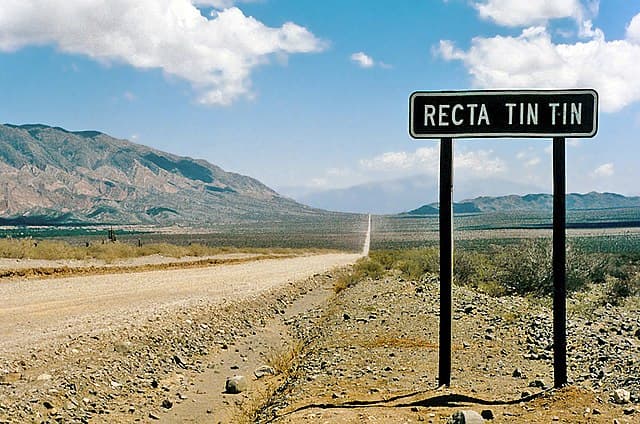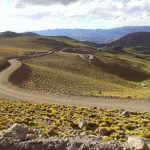Salta Province, Argentina, boasts a road enigma that defies logic and one of the most captivating sceneries in the northwest: the Recta de Tin Tin. A 18-kilometer (11-mile) stretch of asphalt cuts a perfectly straight line through the arid landscape of Los Cardones National Park. The road sits at 3,000 meters (9,843 feet) above sea level and owes its name to a small hill called “Tin Tin.” Cerro Negro, located on the other side of the road, offers one of the best panoramic views of this desert region in Salta.
Tin Tin Straight: An Ancient Road
The Recta de Tin Tin is no modern marvel. Its origin dates back hundreds of years, when pre-Columbian cultures built the road for ceremonial and commercial purposes. It is believed to have been part of the Inca Trail, a vast network of roads that connected different regions of the Inca Empire.
The construction method of the Recta de Tin Tin remains a mystery. Without precision instruments or modern technology, ancient inhabitants managed to trace an almost perfect straight line with millimeter precision. Some researchers believe they used bonfires as reference points, while others suggest they relied on astronomical knowledge.
A Breathtaking Landscape
The Recta de Tin Tin is not only striking for its layout but also for the surrounding landscape. On both sides of the route stretches a sea of cardones, giant cacti that can reach up to 10 meters (33 feet) in height. An arid and fascinating setting that invites reflection and admiration. Countless cactus silhouettes appear on both sides of the road. Although they may seem all the same to the untrained eye, a closer look reveals distinct shapes, tones, and even colors. No two cardones or cacti are alike, just like humans and animals. Each one is unique and unrepeatable.
Dangers and Challenges
Despite its beauty, the Recta de Tin Tin is not without its dangers. The lack of curves and the monotonous landscape can induce drowsiness in drivers, increasing the risk of accidents. Additionally, extreme weather conditions, such as strong winds and sandstorms, can make driving difficult.
For lovers of adventure and history, the Recta de Tin Tin is an unmissable place. Driving or cycling along it is a unique experience that allows you to connect with the past and enjoy the grandeur of the Argentine landscape. Following Route 33 eastwards, you will find Cuesta del Obispo, one of the most dangerous roads in Argentina.
If you decide to visit the Recta de Tin Tin, keep in mind the following recommendations
Drive with caution: Respect speed limits and be aware of the possibility of drowsiness.
Be prepared for weather conditions: Bring water, appropriate clothing, and sunscreen.
Enjoy the scenery: Stop at some points to observe the cardones and take photos.
Respect the environment: Do not leave trash and follow the rules of Los Cardones National Park.
Tin Tin Straight on Google Map
Los Cardones National Park, Argentina
Los Cardones National Park is an Argentine national park located in the Salta Province, in the northwest of the country. It was created in 1996 and covers an area of 64,117 hectares (247.56 sq mi). The park is home to a large population of cardón cacti, some of which are up to 300 years old. The park is located in the Calchaquí Valleys region, which is characterized by its arid climate and mountainous landscapes. The park’s altitude ranges from 2,600 meters (8,530 ft) to 5,226 meters (17,146 ft) above sea level. The park’s flora is dominated by the cardón, a cactus that can reach up to 10 meters (33 ft) in height. Other common plant species in the park include the tola, the jarilla, and the retama. The park’s fauna is diverse and includes a variety of mammals, birds, and reptiles. Some of the most common animals in the park include the guanaco, the vicuña, the puma, the Andean condor, and the cliff parrot. Los Cardones National Park is a popular tourist destination. Visitors to the park can enjoy a variety of activities, such as hiking, camping, bird watching, and photography.
Best time to visit: The best time to visit Los Cardones National Park is during the fall (March-May) or spring (September-November). During these months, the weather is mild and there is less chance of rain.

















